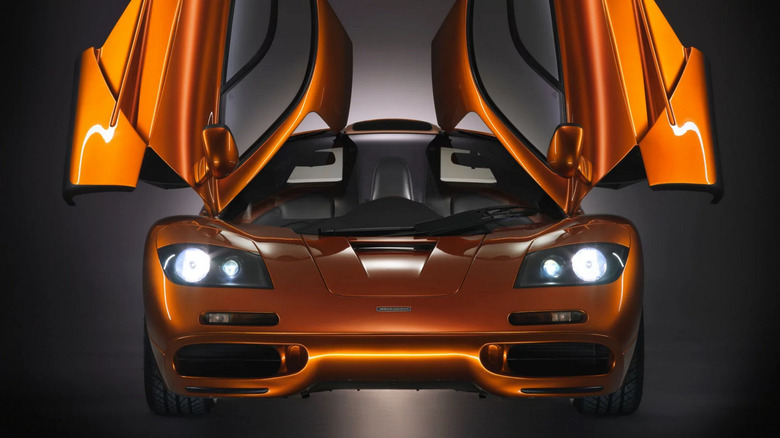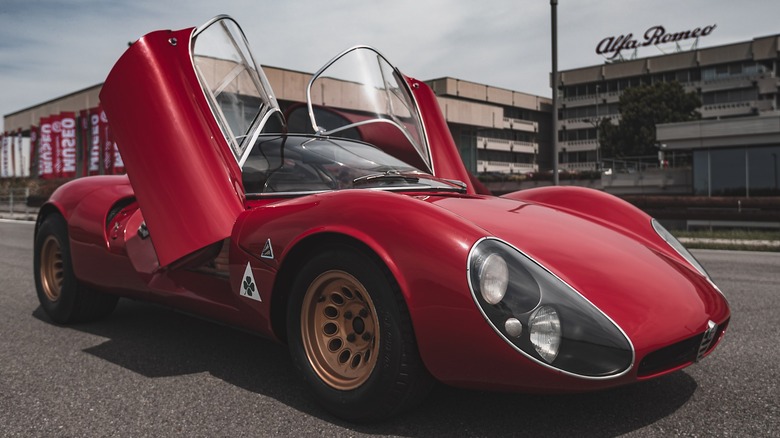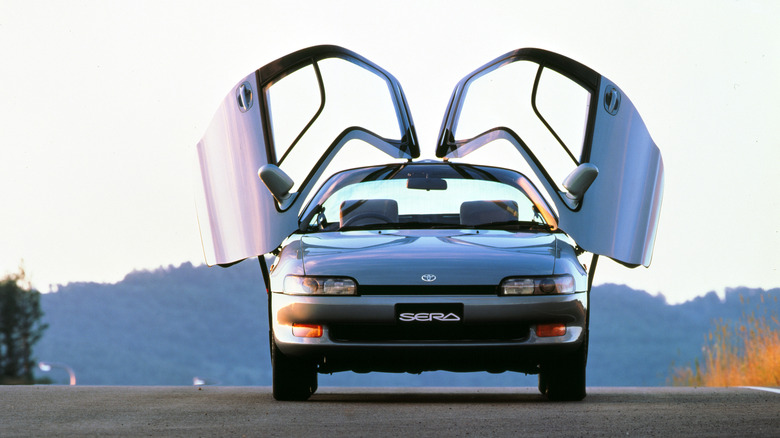Which Classic Car Had The First Butterfly Doors?
Often confused with gullwing doors and sometimes scissor doors, butterfly doors essentially combine these two styles into one. Rather than opening vertically (like gullwings) or horizontally forwards (scissor), a butterfly door features a lower and upper hinge operating on separate axes of rotation, meaning the door opens up and forward. From the front, this looks like the wings of a butterfly spreading out, hence the name. Sometimes they're called "F1 doors" after the most famous car to feature them, the McLaren F1, or by the technical name "dihedral doors," owing to the door utilizing two planes of motion to open.
Remarkably few cars feature butterfly doors, certainly compared to other alternative door mechanisms. However, butterfly doors have a surprisingly long lineage, going back to the 1960s. The first ever production car with butterfly doors is the 1967 Alfa Romeo 33 Stradale, or "Street" in Italian — although it stretches the definition of "production," considering only 18 examples ever left the factory. Designed by Giovanna Scaglione, the Alfa 33 Stradale is often considered one of the most beautiful cars ever made, with its iconic doors among its various eye-catching characteristics.
Scaglione designed the car principally as a lightweight racer, with aerodynamics and aesthetics being primary considerations. These design trends carried over to the few regular-production road cars to utilize these doors, such as the McLaren F1 and Saleen S7 — though like the 33 Stradale, they remain principally a feature of exotics (with one notable exception).
1967 Alfa Romeo 33 Stradale: The progenitor of the butterfly door
These days, Alfa Romeo is best known for producing super-saloons and luxury cars like the Giulia Quadrifoglio and Stelvio. But beneath its deep red veneer lies a long and proud motorsports history that dates back to the 1910s. The 33 Stradale was born directly from this heritage, essentially a roadgoing adaptation of the 1964 Tipo 33 championship-winning prototype series. These cars boasted numerous engines, culminating in a 500-horsepower mid-mounted flat-12 housed in a tubular steel frame, providing an exceptionally low silhouette and center of gravity.
Scaglione modified this platform within the guidelines of the original racer, crafting an aerodynamic, technically impressive, and frankly gorgeous body. This street version came equipped with a 2.0-liter V8 revving to an astonishing 10,000 RPM redline, coupled to a six-speed manual gearbox. All that propelled the roughly 1,543-pound car with exceptional vigor, though the exact top speed depends on the specific car. These were hand-built vehicles with bespoke engines, so the total power output and exact aerodynamic profile aren't certain. But it's generally accepted that it'll go from 0-62 mph in 5.5 seconds and reach a top speed of around 163 mph, depending on how brave the driver's feeling.
The Alfa 33 Stradale is one of the rarest and most unique production cars ever, and it's certainly one of the most expensive, as well. It originally sold for $17,000 (about $160,000 in 2025), but it costs a little more than that today. If you want one, an original 33 Stradale will easily burn a seven-figure hole in your wallet without breaking a sweat.
Contemporary vehicles with butterfly doors
The 33 Stradale received a limited-edition modern supercar iteration, first unveiled in 2023 with an eye-watering $1.6 million price tag. And yes, that variant features butterfly doors. In fact, several modern high-end supercars have butterfly doors, such as the Mercedes-Benz SLR McLaren, the Ferrari Enzo and derivatives like the FXX and FXX K, the McLaren F1 and Senna, and the Maserati MC20. While butterfly doors are certainly unique, they're still not quite as eccentric as the drop-down doors on the BMW Z1 or the doors that rotate vertically on Koenigsegg models.
However, the one common trait shared among all these cars (aside from the doors) is their rarity. This one simple fact means that you'll hardly ever see a car with butterfly doors on the road today. But there is one sole exception to that rule: a quirky, pocket-sized Japanese sports car called the Toyota Sera.
The Toyota Sera is a compact sports coupe with futuristic aesthetics and mechanical components shared with the Toyota Starlet. In other words, it's actually cheap, reliable, and easily-maintained, unlike virtually every other butterfly door car. The Sera was developed right in the middle of Japan's bubble economy alongside other compact and kei sports cars like the Suzuki Cappuccino and Honda Beat, but stood out from the pack with its iconic looks. To date, it remains the only butterfly door-equipped car within reach of the common individual — though it was only ever sold in Japan, so the Sera remains largely seldom-known outside of JDM circles, and is a rarity on U.S. roads in general.


